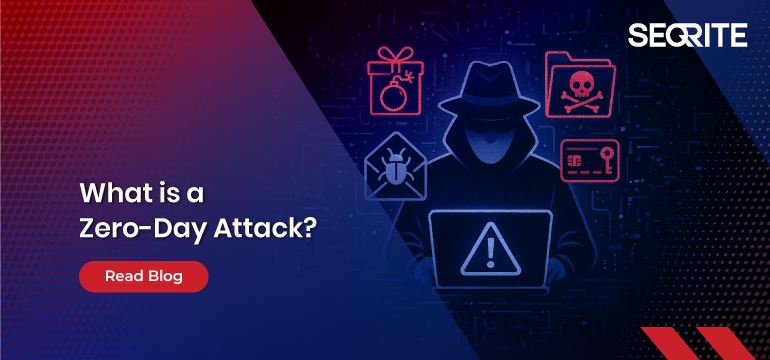What is a Zero-Day Attack?
A zero-day attack is defined as a cyber attack that happens when the vendor is unaware of any flaw or security vulnerability in the software, hardware, or firmware. The unknown or unaddressed vulnerability used in a zero-day attack is called a zero-day vulnerability.
What makes a Zero Day Attack lethal for organizations is
-They are often targeted attacks before the vendor can release the fix for the security vulnerability
– The malicious actor uses a zero-day exploit to plant malware, steal data, or exploit the users, organizations, or systems as part of cyber espionage or warfare.
– They take days to contain, as the fix is yet to be released by the vendors
Examples of Zero-Day Attacks in 2025
As per the India Cyber Threat Report 2025, these are the top zero day attacks identified in 2024, detailing their nature, potential impacts, and associated CVE identifiers.
Ivanti Connect Secure Command Injection (CVE-2024-21887)
A severe remote command execution vulnerability that allows attackers to execute unauthorized shell commands due to improper input validation. While authentication is typically required, an associated authentication flaw enables attackers to bypass this requirement, facilitating full system compromise.
Microsoft Windows Shortcut Handler (CVE-2024-21412)
A critical security bypass vulnerability in Windows’ shortcut file processing. It enables remote code execution through specially crafted shortcut (.lnk) files, circumventing established security controls when users interact with these malicious shortcuts.
Ivanti Connect Secure Server-Side Request Forgery (SSRF) (CVE-2024-21893)
This Server-Side request forgery vulnerability in the SAML component allows attackers to initiate unauthorized requests through the application. Successful exploitation grants access to internal network resources and enables the forwarding of malicious requests, leading to broader network compromise.
Mozilla Firefox Animation Timeline Use-After-Free (CVE-2024-9680)
A use-after-free vulnerability in Firefox’s animation timeline component permits remote code execution when users visit specially crafted websites. This vulnerability can lead to full system compromise, posing significant security risks to users.
How a Zero-day Attack Works?
Step 1: A software code creates a vulnerability without the developer realizing it.
Step 2: A malicious actor discovers this vulnerability and launches a targeted attack to exploit the code.
Step 3: The developer reliazes a security vulnerability in the software yet does not have a patch ready to fix it.
Step 4: The developers release a security patch to close the security vulnerability.
Step 5: The developers deploy the security patch.
The gap between the zero-day attack and the developers deploying a security patch is enough for a successful attack and may lead to a ransomware demand, system infiltration, and sensitive data leak. So how do we protect against
How to Protect Against Zero-Day Attacks?
- Use behavior-based detection tools such as Endpoint Detection and Response (EDR) or Extended Detection and Response ( XDR)
- Keep software updated regularly
- Employ threat intelligence and zero-trust security models
- Partner with cybersecurity vendors that offer zero-day protection, such as Seqrite.

